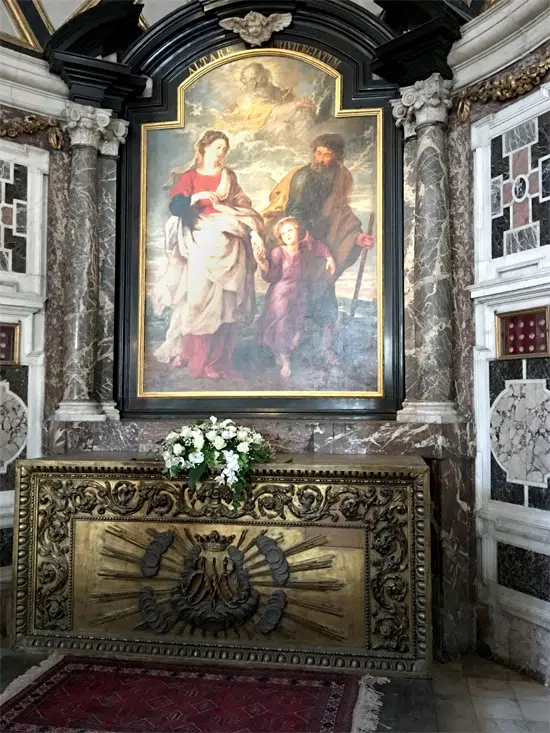ANTWERP, Belgium— A unique event took place in late June at St. Charles Borromeo, one of this city’s five touristic monumental churches. A painting of “The Return of the Holy Family” by Antwerp’s greatest son, artist Peter Paul Rubens, came back to the Chapel of St. Joseph near the chancel after a 240-year absence.
Rubens’ friend Nicholas Rockox commissioned him to depict the young Jesus, accompanied by Mary and Joseph, journeying back to Nazareth after the death of Herod (Mt 2:23). The shaped top of the painting fits perfectly into the frame designed for it in 1624.
Antwerp suffered terribly in the Iconoclastic Fury of 1566. Angry mobs spurred on by an extreme Calvinist doctrine that condemned all religious art in churches, and fueled by anger at the cruel rule of the Spanish monarchy in the Low Countries, stormed through the churches tearing down statues, smashing stained glass, and burning paintings. In 1581, Calvinist Christians seized all the Catholic churches and purified them of “idolatry.”
But once Antwerp became a Catholic city again, it rebuilt, and the newly founded Jesuit church of St. Ignatius, nicknamed the “Marble Temple,” became a jewel in its crown.
Rubens was hired in 1620 to design the entire church, including a high altar that was a technical marvel. Four different altarpieces, matching the liturgical seasons, were painted. A system of hooks and pulleys that still exists in the church lets workers lower one picture and raise another in its place.
Then disaster struck — twice. In 1718, fire swept through the church, destroying the 39 small pictures of the Bible that Rubens had painted over the side aisles and galleries. Only the high altar survived. In 1773, Pope Clement XIV suppressed the Jesuit order, and the church’s name was changed to St. Charles Borromeo. The Hapsburg monarchs who ruled the Southern Netherlands took two great altarpieces to Vienna where they remain in the Kunsthistorisches Museum.
The “Return” was sold into private hands and, at some point, given a square top. Five years ago, someone spotted the lost work in a sale in England. Parishioners of St. Charles Borromeo bought it and paid for five years of costly restoration in Brussels, where the original shape was restored, old repaint and dulling varnish removed, and its brilliant colors revived.
Visitors to Antwerp can hear this whole story recounted with gusto by a guide, one of more than 50 volunteers trained by Father Rudi Mannaerts, an art historian and professor who is also pastor of one of the churches, to escort tourists through the five monumental churches.
The Cathedral of Our Lady is a special treat. During the long renovation of the Antwerp Museum of Fine Arts, altarpieces that once decorated the pillars of the nave are back on view in their original positions temporarily. Our guide confided his hope that the museum, scheduled to reopen in 2019, won’t want them back.
Some of these 16th-century altarpieces were rescued from the Iconoclasts in 1566. They depict Bible scenes cherished by the guilds that commissioned them — the Miracles of the Loaves, for example, is the central story in the altar sponsored by the Bakers Guild. Look up and you will spy tools of the baker’s craft frescoed in the ceiling.
At St. Andrew Church, our guide explained that a statue of St. Peter by Belgium’s greatest sculptor, Artus Quellinus, was returned after being seized by the French in the 1790s, in the second great calamity that befell Antwerp’s churches. Side by side with the Baroque paintings and sculptors, Father Mannaerts has added modern touches.
The ancient statue of the Virgin Mary, carried in procession with glorious robes from various points in her history, now wears a modern gown designed in 2000 by one of Antwerp’s leading fashion designers. A picture near the sacristy titled “What is The Truth?” — Pilate’s question to Jesus — shows heavenly light pooling on the floor in two spaces of a church littered with newspapers and television screens. On the wall above the painting hangs an old picture of St. Francis de Sales, patron of journalists, which was rescued recently from a dusty basement at St. Andrew’s.
A display along the left aisle of the church begins with an infant’s booties and proceeds at intervals through baby shoes, sneakers, skates, cleats, boots, and finally, to a wheelchair and a coffin. “What would you take with you on your last trip?” the exhibit asks.
Father Mannaerts considers himself just a “simple soldier on the battlefield” to combat secularization of churches by educating the general public and the faithful on the deeper message contained in the old art, while constantly bringing in contemporary art and life. He preaches in the local Antwerp dialect at the annual Pentecost Mass, just as the apostles spoke in everyone’s language at the first Pentecost.
Whether teaching at a high school, or at dances or on guided tours, Father Mannaerts said he always wears his clerical collar.
“I am always in uniform,” he said. “Churches must not become museums.”
Hamerman is a freelance writer from Reston.


